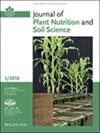Operational Soil Warming by Underground Transmission Lines Impacts on Soil Microorganisms and Related Metabolic Activities
Abstract
Background
During operation, underground transmission lines (UTLs) emit heat leading to soil warming, especially of the subsoil within the cable trench. This fundamentally changes the natural vertical temperature gradient in soil and the environment of microorganisms and may contribute to the variations in microbe community composition, microbial biomass, and microbial, and enzyme activities. Along with this, N-transformation could result in environmental and groundwater pollution by nitrate-N.
Aims
The aim of the study was to decode the impact of operational (sub)soil warming by UTL on soil microorganisms and their metabolic activities specifically in the subsoil.
Methods
At four study sites along an existing 320 kV UTL near Aachen, Germany, soils were sampled from topsoil to subsoil at 120 cm depths from UTL and control sites. A supplemental laboratory experiment was established to investigate soil samples from the entire soil at specific temperature and moisture conditions.
Results
UTL operation resulted in low (0.6K) to moderate (1.7K) soil warming in topsoil and subsoil, respectively, which partly increased soil DNA content and microbial biomass, abundance of soil bacteria, and metabolic and enzyme activities, especially in subsoil samples. For example, in the topsoil soil, microbial biomass was 13% higher in UTL relative to control and increased extraordinarily by 35%–37% in the subsoil. The abundance of soil bacteria was as well enhanced, but no effect was found for amoA copy numbers. Total Nmin contents were lower in UTL compared to control sites indicating that probably N uptake by vegetation was as well increased.
Conclusions
In prospect of the imminent grid expansion of extra-high voltage transmission lines, there was substantial evidence that the operation of underground cables will not have any critical impact on soil microorganisms and their metabolic activities.


 求助内容:
求助内容: 应助结果提醒方式:
应助结果提醒方式:


